Attention: Goji Berry Lovers...
How To Grow
Your Own Goji Berry Plants.
Discover how you can grow your own...
and when you can expect your first harvest.
PLUS... How a little known piece of American history
and a fortuitous gift means you can now grow a
extremely hardy Goji berry in your own garden. Continued below...
|
I will receive three 4 to 6 inch plants ready for planting. During shipping, the roots are kept moist in a rock wool soil-less growing matrix.
Call Rachel or Mike at 303-642-0277 |
|
Nederland, CO From the Desk of Rachel Thorogood
So you want to grow your own? It's fun being self sufficient. Growing your own food is one great way to do this. Besides, then you know it's pure and clean, because you nurtured it yourself. |
 Rachel Thorogood Health Advocate |
|
This is a true story of the American West. Read on... In 1869 the rush was on to connect the Central Pacific, coming from the east, and the Union Pacific, coming from the west, railroad lines to form the very first transcontinental railroad. On May 10, 1869, the two railroads finally were joined in Promontory Summit, Utah, in the forbidding Utah desert north of the Great Salt Lake. This meant that instead of it taking 4-6 months to cross the country by covered wagon, suddenly it took only 6 days on the train.
Chinese labor had been used to build other California railroads, and now 3600 of them were hired once again at $28 per month (the other laborers were Irish.) The Chinese were considered to be efficient workers and far less troublesome than the Irish. The work was extremely dangerous, what with blasting through mountains and laying track and railroad ties over the treacherous terrain of the high Sierra mountains. They used primitive techniques such as chipping away at granite while hanging in baskets on ropes from the tops of cliffs. Many Chinese died in the harsh winters and perilous conditions.
If it were not for these tireless Chinese workers and their families, the progress and development of the U.S. as a nation would have been delayed by many years. They labored for little money in terrible working conditions in severe weather. Their contribution was remarkable. The Chinese workers lived in simple tent towns. They did all their own cooking, and when they arrived to work they brought a lot of traditional Chinese food in dried form, such as oysters, fish, mushrooms, seaweed and fruit, including goji berries. Traditionally, the Chinese cook many dishes with goji berries. The Chinese had large dining camps which moved as they moved along the railroad route, particularly the one at Dove Creek Camp, near Promontory, Utah, where they lived for a while, continuing to work for the Central Pacific Railroad. The Celestials planted goji vines from seed and
they threw out their garbage into the desert, which was also filled with goji
seeds. When the Golden Spike was pounded into the last railroad tie, and the
cleanup was complete, most of the Chinese workers returned to the West coast.
The town of P However, the goji berry seeds germinated and grew into tiny plants, then into bigger vines, and they have continued to thrive ever since for the past 141 years. The birds have eaten most of the yummy crop. Plants have been dug up from this large, wild patch of Lycium Barbarum and propagated. They are extremely hardy and grow fast and vigorously. I was gifted with a few of these plants and given the mission to spread these Goji plants all over America. This is why they are now available for your own garden. |
Where Do Goj Berries Like to Grow?
 Goji Berries are also known as Lycium Barbarum or Chinese Wolfberry. The plants are
deciduous, woody perennials and are
very adaptable. They like lots of sun, preferring climates that are hot
and dry in the summer, but they will grow just about anywhere, including in
humid climates.
Goji Berries are also known as Lycium Barbarum or Chinese Wolfberry. The plants are
deciduous, woody perennials and are
very adaptable. They like lots of sun, preferring climates that are hot
and dry in the summer, but they will grow just about anywhere, including in
humid climates.
My strain of Lycium Barbarum grows naturally in Zone 5. See that little white spot at the top of Utah? That's the Great Salt Lake. My Goji plants came from just to the left of the Great Salt Lake.
These Goji berries should do well in zones 4 to 9. You can grow them in greenhouses in zone 1 to 3 because the dormant roots may not survive the winter.
There are several species and as many as 88 varieties. The most sought after species is Lycium Barbarum because it is the most nutritious.
At this time (2010) the only commercial source in the world for goji berries is from China or Mongolia. All shipments from Mongolia must go through China. This means that those of us who love our goji berries are beholden to the whims of the Chinese government in allowing goji trade as well as to the fears of the USDA in allowing the berries to be imported.
But due to a little known piece of American history (see right), there is a hardy stock of Goji Berries that has adapted itself to North America. Now you can have access to a hardy, mature stock of goji plants to grow your own Goji Berries.
Remember Johnny Appleseed?
Fast forward and think: Johnny Goji-seed
 Imagine...
Imagine...
- Goji plants grew in people's yards all over the U.S.
- You could go out to pick some berries for your breakfast and grow enough for your whole family
- You could go to the local goji farm and pick your own
YOU can be part of the Grass Roots (so to speak) Movement for Goji to become a common plant in the U.S.!
JOIN GOJI UNDERGROUND (and above-ground) TODAY!
All aboard the Goji Express! Do your little part! Lots of little goji plants make lots of goji berries and freedom from expensive and restrictive overseas government and shipping policies. FREEDOM NOW from Big Fruit tyranny!!!
All for one and one for all. Join the Goji Manifesto. Unite for superfruit!
At last, something we can all agree on!
How do you grow Goji shrubs or vines?
You can buy a goji plant from a nursery. But you can also grow healthy goji plants from plant cuttings or from seed.
 Growing Goji Plants from Cuttings
Growing Goji Plants from Cuttings
Using 21st century plant propagation technology, I have developed healthy goji plant cuttings from strong, mature goji plants. These "bare root starts" are cuttings from a mature Goji plant. They have already formed roots. Goji naturally likes to send out runners, so cuttings readily take root. These starts grow quickly into large goji plants.
The goji plants I have are the species Lycium Barbarum (they have been genetically tested.)
 Here
is a happy goji cutting (or rooted cutting) with healthy roots ready to be
planted in soil. The cuttings come with the roots encased in rock wool to
keep them moist during shipping.
Here
is a happy goji cutting (or rooted cutting) with healthy roots ready to be
planted in soil. The cuttings come with the roots encased in rock wool to
keep them moist during shipping.
I will send you 3 rooted cuttings to make sure you have success in starting your goji hedge.
Any good quality gardening soil should work. However, add enough sand so that any excess of water can drain easily if possible. The ratio should be 1/3 sand to soil. Goji berries grow in an alkaline soil of a ph of 8.2 to 8.6 in their natural habitat.
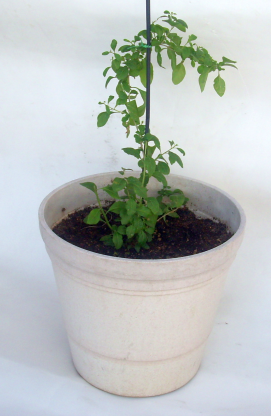 I suggest planting your small Goji
shrubs in 5 gallon buckets, with drain holes punched in the bottoms. That way
you can move them around if you need to. The full size shrub can grow to 8 feet,
and tends to be slightly wider than tall. However, they won't get that
large in a bucket. This is because the plant stops growing once the roots
hit bottom. Goji plant roots need to go deep. You want to create an
environment where the roots can go deep rather than wide, and this is why a 5
gallon bucket works well.
I suggest planting your small Goji
shrubs in 5 gallon buckets, with drain holes punched in the bottoms. That way
you can move them around if you need to. The full size shrub can grow to 8 feet,
and tends to be slightly wider than tall. However, they won't get that
large in a bucket. This is because the plant stops growing once the roots
hit bottom. Goji plant roots need to go deep. You want to create an
environment where the roots can go deep rather than wide, and this is why a 5
gallon bucket works well.
It is better to start them inside. Once the plants have grown big and strong, you could plant them in a row outside, several feet apart. The goji plants will send out runners, and soon you will have a goji patch, so plan ahead for that.
The Goji plant is quite hardy. It likes full sun except in hot climates. What else would you expect from a plant that originated in the Himalayas?
How Quickly Can You Expect Your Own Berries?
 Hopefully you’re not in a hurry for the berries. The
shrubs don’t usually bear fruit until about the third year. But you can use the
leaves in a salad while you wait.
Hopefully you’re not in a hurry for the berries. The
shrubs don’t usually bear fruit until about the third year. But you can use the
leaves in a salad while you wait.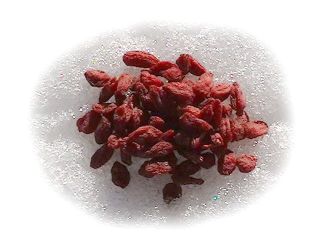 You’ll know your shrubs are about to bear fruit because you’ll start to get
small purple/white trumpet flowers from summer until the first freeze.
You’ll know your shrubs are about to bear fruit because you’ll start to get
small purple/white trumpet flowers from summer until the first freeze.
You can get your Goji shrub to become more bushy by
nipping buds so that it forms more branches.
A wide variety of animals such as rabbits, birds and
deer also like to snack on the berries . Beware of the tomato worm and other insects.
When I first started growing Goji plants, I was mystified when most of my
biggest plant disappeared overnight shortly after I put it out in its second
spring. The next afternoon, I caught a Jay trying to eat most of what
was left. It seems we are not the only ones that think the leaves
make a dandy salad.
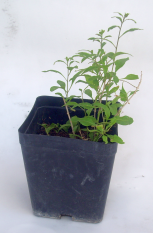 Once you’ve got a good shrub going, you can further propagate your plants by taking
cuttings. The plants grow up to 1 yard high unless you give them something
to lean against. The stems have green, lance shaped leaves. They bloom with small, purple-blue flowers.
Once you’ve got a good shrub going, you can further propagate your plants by taking
cuttings. The plants grow up to 1 yard high unless you give them something
to lean against. The stems have green, lance shaped leaves. They bloom with small, purple-blue flowers.
Ah, finally, at long last – the harvest. Pick your Goji berries carefully; they bruise very
easily. Also, there is no fast way to pick them, so be sure to leave
plenty of time.
As your goji shrub grows, year after year, the berries will become larger and more nutritious. This is like the wine grape - older vines produce better grapes.
For 2 truly excellent articles by Donald R. Daugs about growing woflberries, click on these 2 links, especially the second one: Wolfberries: exceptional nutrition in a small package. Wolfberry update.
There are many places in England where wolfberry shrubs are used as hedges. They can be grown as a barrier along a road in place of a fence if desired.
[Trimming Goji Berry Bushes
But what if you don't want your Goji berry bushes, shrubs, trees etc. to be a unruly hedge? Well, then you've got to prune them!
Major pruning is done when the plant is dormant, except for dead, broken or diseased branches. It is also easier to see the shape of the bush at this time. In general you want a cylindrical plant that tops out at 6 feet tall, with branches spaced so that wind and sun can reach into all parts of the plant. Remove side branches that are within a foot of the ground.
However, you will also need to prune when the plant is growing to help it keep a cylindrical shape. The idea is to encourage horizontal growth and discourage vertical growth except for one main branch. In particular, any fresh branch that starts to grow straight up should be removed immediately.
Another thing to watch out for is root sprouts. These need to be cut out as soon as you can so that you don't end up with a unnavigatable bramble.
]
Growing Goji Plants from Seed
Each goji berry has about 30 tiny yellow seeds inside. They are smaller than tomato seeds. These seeds will germinated in about a week.
If you wish, you can simulate a
hard winter by freezing the berries for about a month. (You can also skip
this step.)
Soak several goji berries in good water in a germinating tray. This feels like a wet spring thaw to the berries.
In a week to 10 days they will germinate, getting little roots. Then they're
ready for planting in starter pots. Typically, about half the seeds will
germinate.
Prepare your “soil” from a mixture of worm castings and biological compost, with
enough sand so that any excess of water can drain easily. Goji berries grow
in an alkaline soil of a ph of 8.2 to 8.6 in their natural habitat.
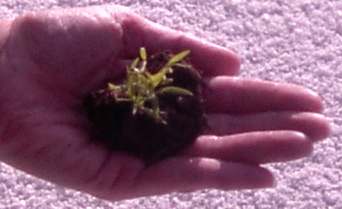 Plant the germinated berries about half an inch down in starter pots, deeper for very large berries. In our experience, it
will take 10-14 days for them to start coming up. The first green shoot
will have leaves so tiny that you have to look very carefully to even see them.
The plant is adaptable once it sprouts.
Plant the germinated berries about half an inch down in starter pots, deeper for very large berries. In our experience, it
will take 10-14 days for them to start coming up. The first green shoot
will have leaves so tiny that you have to look very carefully to even see them.
The plant is adaptable once it sprouts.
My experience is that they grow rather slowly the first few months. At
that point the roots reach the bottom of the pot. Once that happens, the
plant stops growing, so it is best to provide the plant with a deep pot.
You want the roots to go deep rather than wide.
When the rooted cuttings have outgrown their starter pots, you can put your small Goji
shrubs in 5 gallon buckets, with drain holes punched in the bottoms. That way
you can move them around if you need to. The full size shrub can grow to 8 feet,
and tends to be slightly wider than tall. However, they won't get that
large in a bucket. This is because the plant stops growing once the roots
hit bottom.
Update, March 2009: In the two+ years that
this article has been here, we've yet had anyone call to tell us that they've
had great success growing a Goji hedge from seed. The only successes we've
heard about are when the hedge was started with a cutting. You can take
further cuttings once you've got one plant growing well.
You’ll probably want to be eating the berries while your Goji berry garden matures for a few years. After all, you’ll want to experience the powerful nutrition of the goji berries in the meantime. Why not buy more than just a few berries?
If you buy 9 pounds, that should last you about a year!
However, if you find yourself gulping them down because your body craves them,
this is a good thing, and you can buy more when you run out.
|
|
For more great information about Goji berries, including more Goji-growing tips, go to my Goji berries homepage.
Signed,

Rachel Thorogood
P.S. As an avid gardener myself, I know what it's like to want to grow your own. But I also want to have the strength and energy to enjoy my gardening. There's nothing like the gentle buzz I get from eating a few handfuls of Goji Berries BEFORE I head out into the garden. By the time you've finished a 9 lb. bag, you'll know what I mean AND you'll be well on your way to growing your own crop of Goji Berries.
Legal Disclaimer |Terms of Use |Privacy Statement
© 2015 The Happy Fruit, 2525 Arapahoe Ave #E4-820, Boulder CO 80302


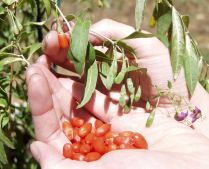

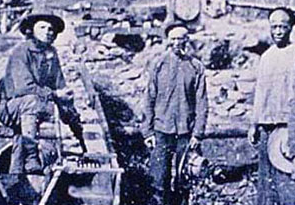
 romontory
and Dove Creek Camp emptied of people and into the terrible soil of the desert.
romontory
and Dove Creek Camp emptied of people and into the terrible soil of the desert.